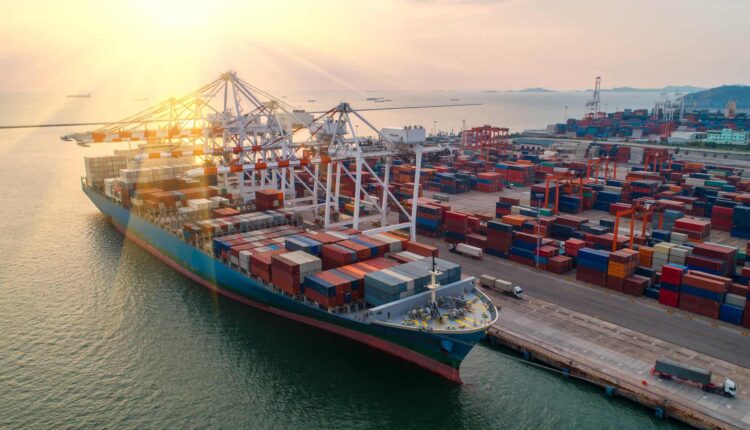SeaNEWS – International Service – The container ship charter market in week 46 of 2025 continues its gradual correction trend, according to the latest assessment of the New ConTex index. Published on November 13, 2025, the report shows that freight rates have decreased across many vessel sizes; however, these declines have been entirely controlled, and the market remains strong and stable compared to historical averages. In fact, what is currently observed in the market reflects more of a structural normalization than a sharp fall.
A Picture of “Normalization,” Not a Collapse
The New ConTex index recorded 1,498 points this week, representing a 0.5% decrease compared to last week, while the year-on-year comparison shows an 11% growth. This significant difference highlights the market’s resilience to recent pressures and confirms that demand in key sectors remains high. Analysts of the index believe that market behavior at this stage of the cycle is in line with expectations, consistent with the wave of new deliveries and adjustments following last year’s sharp rate increases.
In the smaller or feeder vessel segment, particularly the 1,100 TEU and 1,700 TEU sizes, stability remains notable. The six-month charter rate for 1,100 TEU vessels this week was approximately $17,082, showing only a 1% weekly decline, yet representing a 16.3% increase compared to last year. These vessels continue to attract attention from European, Caribbean, and West African feeder networks. High demand for shallow-draft ships with suitable reefer capacity has kept the supply of this class extremely limited. As a result, charterers often prefer longer-term contracts to secure operational requirements.
A similar pattern is seen in the 1,700 TEU segment. The six-month rate for these vessels reached $29,348, showing only a 0.4% decrease but a significant 24.8% increase compared to last year. This class plays a pivotal role in intra-Asia routes and Mediterranean networks. Despite some disruptions caused by the Red Sea situation and seasonal cargo fluctuations, it remains one of the most stable market groups. Shipping lines continue to enter the market early to secure vessels of this size, maintaining operational flexibility on sensitive routes.
2,700 TEU – The Largest Drop Among Medium Sizes
The medium-sized vessel segment, including 2,500 to 4,250 TEU vessels, has experienced the most noticeable correction, although still within reasonable bounds. For the 2,500 TEU size, the twelve-month rate was around $33,898, reflecting a 0.4% weekly decline but a 14% increase year-on-year. This size, important for regional routes, has faced pressure from new deliveries but continues to trade at high levels.
The decline in the 2,700 TEU size is more pronounced. The twelve-month rate for these vessels was reported at $35,614, a 0.7% drop from last week. Nevertheless, this rate is still 12.8% higher than last year. The main factors behind this rate drop are the influx of newly built vessels and reduced demand on certain east–west and north–south routes. Despite these conditions, shipping lines are still pursuing 12- to 24-month contracts to secure fleet requirements for Q1 2026.
In the 3,500 TEU segment, the twelve-month rate was $42,010, reflecting a 0.5% weekly decrease. This size is utilized on many deeper and regional routes. Despite being in a downward trend, it remains significantly higher than normal historical levels. Analysts suggest that the behavior of this segment reflects the start of a gradual adjustment rather than a serious market weakness. The 4,250 TEU size has also seen a limited decline. The twelve-month rate for this class was reported at $50,790, showing a minor 0.1% decrease, with 24-month rates down by 0.4%. This group, typically highly stable, is now affected by increased supply and adjusted demand but still trades at elevated levels.
For larger vessels, including 5,700 TEU and 6,500 TEU sizes, rates have remained largely unchanged. The twelve-month rate for 5,700 TEU vessels is around $59,772, virtually unchanged, while the 6,500 TEU rate remains stable at $66,481. This stability indicates that although the large-vessel market has not returned to previous peaks, it has not experienced significant downward pressure. Charterers in this segment continue to act cautiously, primarily offering medium-term contracts.
Market Outlook: Stability in Feeders, Opportunities in Medium Sizes
Overall, market behavior in week 46 confirms that we are still in a phase of natural market correction. The wave of extensive deliveries that began in 2024 and peaked in 2025 is now impacting freight rates. At the same time, demand levels on many routes remain acceptable, preventing sharp declines. Additionally, geopolitical factors—particularly crises in the Red Sea and strategic straits—support freight rates and prevent severe drops.
The outlook suggests that feeder sizes will remain in a strong position, especially given the implementation of new EU ETS and FuelEU Maritime regulations, which increase the demand for small, efficient vessels. Meanwhile, 2,500 to 4,250 TEU vessels are likely to see opportunistic behavior from some charterers pursuing long-term contracts, as early 2026 volatility remains a concern. For larger vessels, the current relative stability is expected to continue unless significant changes in global cargo volumes or geopolitical conditions occur.
In conclusion, the container charter market in week 46 has entered a phase of calm, rational adjustment. This adjustment is essential for market health and creates a more predictable framework for both owners and charterers. In such an environment, the market remains strong and offers important opportunities for medium- and long-term planning.

